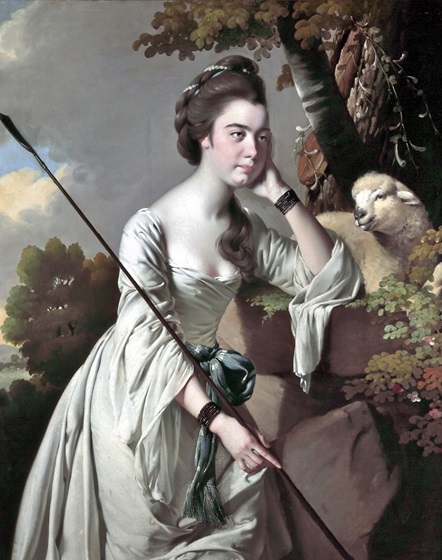The Hidden Story of Anna Ashton
Posted on: 19 August 2022 by Amanda Draper, Curator of Art and Exhibition in 2022
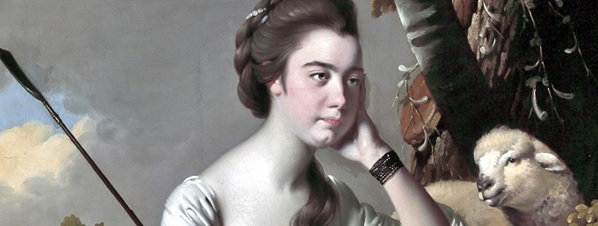
Anna Ashton was from a wealthy Liverpool family of the 1760s but poses here as a shepherdess complete with lamb. There is nothing obvious that links this rather charming portrait to the Transatlantic slave trade, but that is the hidden story.
Anna Ashton, later Mrs Thomas Case, c.1769 by Joseph Wright of Derby. (oil on canvas) VG&M Collection
The Shepherdess
As with the majority of women of the era, little is known about Anna herself. A birth record in her name gives a year of 1747, making her 22 when her portrait was painted around 1769. She is dressed as a shepherdess and holds a houlette, a type of French shepherd’s crook. A lamb sits at her left elbow and peers out at the viewer with a curious expression. However, Anna was no impoverished rural farmer’s daughter; her gown is made of sumptuous silk and there are pearls in her hair. Depicting women from wealthy backgrounds as shepherdesses was a tradition in portraiture both here and in France dating back to the 1660s. It gave a reason to paint the sitter in a countryside setting and was perceived to be romantic, with the shepherdess attire being considered flattering and attractive. Of course, it had absolutely no resemblance to the harsh realities of rural life and the difficulties of women actually working in that environment.
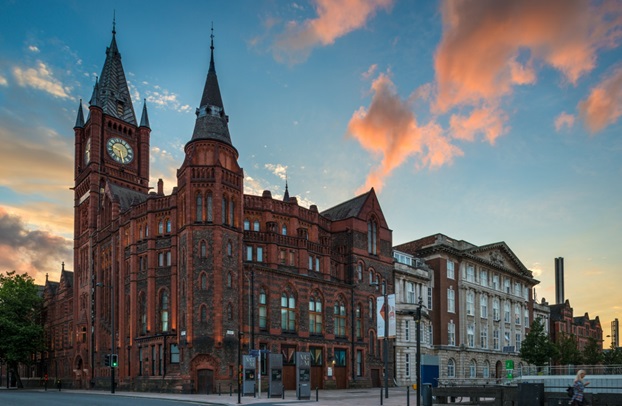
Victoria Building with Ashton Street along the right façade. Photo by McCoy Wynn, 2016
The Ashton Family
Anna was the daughter of John Ashton (1711 – 1759), a rich Liverpool merchant who traded in salt and coal but also invested in and profited from the slave trade. Several places in Liverpool are named after him such as Ashton Street on which our Victoria Building stands. He died around ten years before the portrait was painted but his son, Nicholas Ashton (1742 - 1833), had taken over the family business and commissioned a series of family portraits from one of the leading artists of the day, Joseph Wright of Derby. They were likely to help commemorate Nicholas’ elevation to High Sheriff of Lancashire in 1769. Nicholas is believed to have had little involvement in the slave trade, even showing support for Abolitionist campaigners, but the links to slavery adhered to the Ashton family. Nicholas’ son, also called John Ashton (1765 – 1814), left interest in Jamaican plantations (with their enslaved labour) in his will.
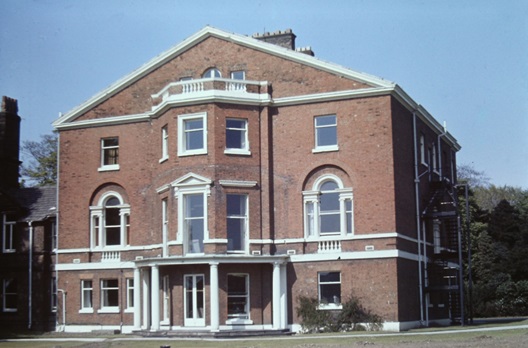
Red Hazels (also known as The Hazels), Prescot, Built in 1764 and home of Thomas and Anna Case. This Grade II listed building is now much deteriorated. Image and usage permissions: Courtesy of Knowsley Archive Service.
The Husband
In 1776, at the relatively late age of 29, Anna married Thomas Case (1731 - 1790), an investor in coal and in the slave trade who lived in Prescot. He owned ships outright, had investments in a further eighteen slaving vessels and was a member of the African Company of Merchants in Liverpool. This was an organisation founded in 1752 to support trade to the Gold Coast on what is now Ghana, especially the trade in enslaved Africans. The name ‘John Ashton’ appears on the list of Liverpool founders and is probably Anna’s father. The Liverpool Records Office holds account books for the partnership of Thomas Case and Nicholas Southworth, listing their extensive trade with Kingston, Jamaica during the period 1754 – 1769 which included enslaved Africans. Case was declared bankrupt in 1778 following the failure of a coal mining enterprise.
Was the marriage of Thomas and Anna a dynastic arrangement between two of Liverpool’s wealthy merchant families in which Anna had little say? Or was it a genuine love match? We do not know. The couple quickly had two sons: Thomas Case junior (1777 – 1845) and John Ashton Case (1779 – 1836). Whatever the ills of the parents, the sons became successful with Thomas Jnr becoming Lord Mayor of Liverpool (1817 – 18) and John working in the legal field.
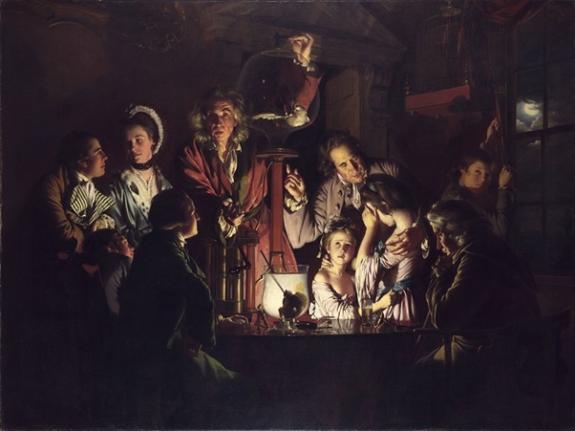
An Experiment on a Bird in the Air Pump, 1768 by Joseph Wright of Derby (oil on canvas). Collection of the National Gallery, London. https://creativecommons.org/licenses/by-nc-nd/4.0/
The Artist
Anna’s portrait was created by Joseph Wright of Derby (1734 – 1797), considered one of the leading portrait painters of the 1700s, and without parallel for his dramatic handling of light and shadow in subject paintings such as An Experiment on a Bird in the Air Pump (1768, National Gallery) shown above. Always known as ‘of Derby’ to differentiate himself for another artist Joseph Wright, he was born in the Irongate area of the town. He trained in London before settling back in Derby in 1753 but, probably for commercial reasons, he spent the years 1768 – 1771 in Liverpool. Here, Wright focussed on portraiture and found an enthusiastic clientele amongst the merchant elite, many of whom had grown wealthy on the profits of the slave trade in one way or another. It is at this point he was commissioned by Nicholas Ashton to paint his mother and siblings, including Anna. Oddly, there is no record of a painting of Nicholas himself and it is presumed lost.
The question arises of Wright’s own views on slavery. Clearly, he did not object to being paid from income derived from the trade, but he was also friends with Josiah Wedgwood, whose ceramic medallion with a kneeling, chained Black man surrounded by the words ‘Am I Not a Man and a Brother?’ became an icon of the Abolitionist campaign. Wedgwood was a member of Birmingham’s Lunar Society, where several other leading members like Erasmus Darwin and Joseph Priestley were also Abolitionists. Wright was seemingly a peripheral member of the society but definitely moved in that friendship group.
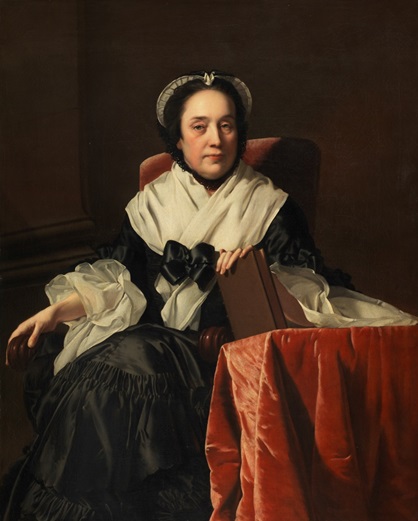
Portrait of Mrs John Ashton, c.1769 by Joseph Wright of Derby (oil on canvas). Collection of the Fitzwilliam Museum, Cambridge. https://creativecommons.org/licenses/by-nc-nd/4.0/ This is Anna's mother, who she strongly resembled, aged 59.
The missing death
And so back to Anna. Like most of the women of her time, her life and her thoughts remain a mystery. No diaries or biography illuminate her life. We have no idea what she thought of her family’s relationship to the slave trade. We don’t know if she was happy in her marriage and, even if she wasn’t, divorce was almost impossible at that time. Any money and property she brought into her marriage, or inherited during it, automatically became her husbands, so we can really only trace her life through the men around her.
We do know that her elder son, Thomas junior, became an insurance broker and owner of Liverpool’s Herculaneum pottery company. Before being elected to Mayor of Liverpool, he was an Alderman who supported philanthropic and liberal causes. He owned Thingwall Hall in Knotty Ash during the early 1800s, and before that lived at what has been described as the ‘family estate in Prescot*, presumably Red Hazels, which he sold in 1803.
There had been no trace of Anna in genealogical searches after the birth of her sons and no apparent record of her death. However, a woman named in Prescot burial records as Hannah Case was listed for 1814. Given the family connection to the area, we have to presume this is the missing Anna. It was fairly common for the names Ann/Anna/Hannah to be interchanged in legal documents of the period, but poignant that her life ends without a definite record. She would have been 67.
The portrait
The portrait of Anna Ashton, later Mrs Thomas Case (to give its full title) was purchased by the University with the support of the V&A Purchase Grant Fund in 1984. It was considered a good example of a portrait by Joseph Wright of Derby from his time in Liverpool and also had links to our building through the Ashton name. At that time little thought was given to the wider context. While it remains a marvellous portrait by a leading British artist of the 1700s, we are now able to look at the portrait through a different lens. It is currently featured in our display linked to The World Reimagined programme, an education project about Black history and achievements, which runs until 31 October 2022.
Further information
Liverpool street names and their link to the Transatlantic slave trade
Thomas Case and family:
British Online Archives – The Case and Southworth records
*Peter Hyland: The Herculaneum Pottery – Liverpool’s forgotten Glory (National Museums Liverpool & Liverpool University Press, 2005)
Joseph Wright of Derby:
Benedict Nicholson: Joseph Wright of Derby, Painter of Light. London, Routlege and Kegan Paul, 1968
Judy Egerton: Wright of Derby (Exhibition catalogue). London, Tate Gallery, 1990
Keywords: Anna Ashton, John Ashton, Thomas Case, Transatlantic Slave Trade, Joseph Wright of Derby, Liverpool, Ashton Street.
